System Restore is a very useful feature available in Microsoft Windows. This feature allows you to undo any recent changes to the OS and restore it to a previous version.
The System Restore can be used when you want to fix issues caused by a recent change. But, does System Restore restore deleted files? That’s a question that comes to anyone’s mind who has used Windows or plans to use the System Restore feature.
So in this guide, we will tell you everything you need to know about this feature! We will start with how the System Restore works, and then we will also shed light on whether it’s possible to restore deleted files with this feature. In the end, we will show you how to restore deleted files in Windows 10.
Part 1: How Does the System Restore Work?
Microsoft Windows has a built-in feature called the “System Restore”. The System Restore can be useful if you have made any recent changes to the system and encountered an issue, for example, you face issues after a driver update, software installation, or changing the system settings.
This feature makes it easy to undo any recent changes without affecting your data. So, it’s an easy way to fix system issues without losing your precious data.
The System Restore is an automatic system that creates snapshots of your system settings at different intervals. These snapshots are created automatically during software installation, driver updates, Windows updates, and so on.
When the System Restore is used, it reverts any changes to the registry settings, system files, drivers, or installed programs.
Part 2: How to Create a System Restore Point?
Creating a System Restore Point is a very straightforward process and helps you to revert your PC to a previous state. Here’s how to create a System Restore point:
1. Open System Properties
Press the Windows Key + S and type “Create a restore point”. After that, click on the relevant result to open System Properties.
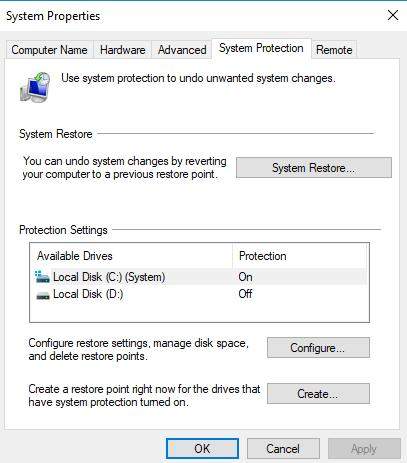
2. Configure Restore Settings
You will see the System Protection tab with different options. You need to select the system drive (usually C:) and then click on the Configure button.
Now, turn on the “System Protection” and then adjust the max usage slider. You must allocate sufficient disk space for the restore points. In the end, click on Apply and then OK.
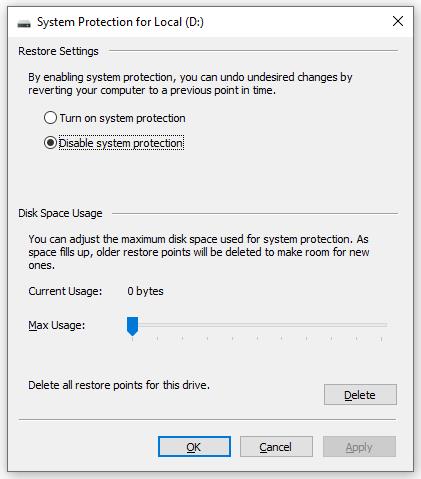
3. Create the Restore Point
Click on “Create” and then enter a name for the restore point. After that, click on the Create button again and wait until Windows creates a restore point on your computer.
Once the process is complete, you will see a confirmation message on the screen. After that, just click on Close to exit the window.
Congratulations! Your system restore point is now successfully created and can be used if something goes wrong on your PC.
Part 3: How to System Restore Windows 10?
Now, let’s look at how to do a System Restore in Windows 10:
- Press the Windows Key + R and then type rstrui.exe. After that, press Enter or the OK button.
- You will now see the System Restore tab on your screen. To proceed, click on Next.
- Select a restore point from the list of results. If you don’t see a specific restore point, click on “Show more” to view the full list.
- After selecting a restore point, click on Next > Finish.
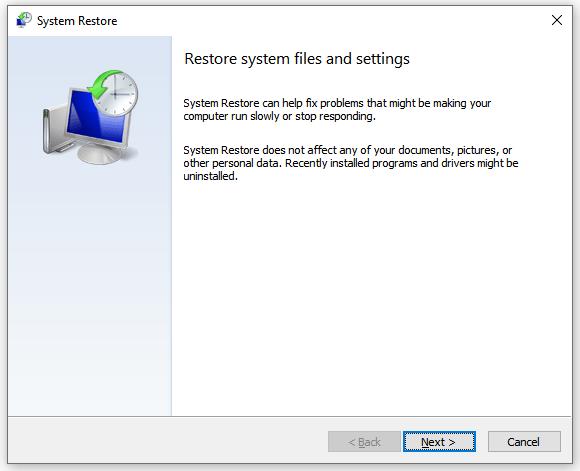
After this, Windows will restart automatically and revert your PC to a previous state. So, if you were wondering how to restore the system to a previous date, just follow these simple steps.
Part 4: When Should a User Consider Restoring Operating Systems?
The best time to use the System Restore is when your computer starts to experience problems after a recent change. The System Restore makes it easy to fix any system-related issues without affecting your personal files.
Here’s a list of some common situations when you should use System Restore:
1. Faulty Driver
Many people start to experience issues after installing or updating a driver. For example, the system might start to crash unexpectedly or freeze all of a sudden. In such situations, it is best to revert the system back to a previous state before the driver was installed.
2. Software Installation
Installing software can sometimes also cause conflicts with system files or other programs. But things get serious when even uninstalling the software doesn’t fix the issue!
So in such situations, the only viable option left is to restore your system to a previous point.
3. Windows Update
Windows updates are meant to improve performance, security, and introduce new features. But it’s also common to start facing crashes or compatibility issues after a Windows Update.
Once again, this can be a reason why someone would consider restoring the operating system.
4. Unstable System
In some cases, the computer starts running unusually slowly, or you start to experience crashes. Also, unexpected errors can start to show up after making some recent changes.
A slow or unstable system can also require you to restore the system to an earlier restore point.
5. Changing System Settings
Changing the system configurations, registry, or advanced issues can also cause issues with the computer. Things get more complicated if you no longer remember what changes you made, or you can’t reverse the changes.
So, an easy fix in this situation is to use System Restore to revert the changes safely.
Part 5: Does System Restore Also Restore Deleted Files?
A question that comes to everyone’s mind is, does System Restore restore deleted files? The answer is No! System Restore doesn’t restore the personal deleted files, such as photos, videos, and documents.
This feature is specifically designed to fix system-related issues and is not meant to recover data. The System Restore feature only affects registry settings, system files, drivers, and so on. This feature doesn’t touch any of your personal data in different folders.
The System Restore affects these:
- Windows Updates
- Installed Programs
- Drivers
- Windows Registry
- System Files/Settings
The System Restore does NOT affect these:
- Personal Files
- Saved Data
- Downloads
- Files stored on other partitions/external drives
So if you had some files that you deleted or are lost, then you can’t really use the System Restore feature at all. Instead, you will need to use a data recovery tool that is specifically built for restoring the deleted/lost files.
Part 6: How to Restore Deleted Files in Windows 10?
So, if the answer to “Does System Restore restore deleted files?” is no, then how can you restore deleted files? Well, you can easily recover deleted files on a Windows computer by using iToolab RecoverGo Windows Data Recovery.
iToolab RecoverGo offers these powerful features:
- Easily recover photos, videos, documents, audios, and other file types.
- No matter how you delete the files, it can get them back.
- Recover from any storage devices, like PC, SD cards, USB flash drive, etc.
- Guarantee a fast recovery process and a high success rate up to 99%.
- Free to scan your storage device and preview the data.
Now, let’s look at how to use iToolab RecoverGo to recover deleted files in Windows 10:
Step 1 Install RecoverGo on your computer and then launch it. After that, choose a location from where you want to recover the data. After choosing a drive or a folder, click on the “Search for Lost Data” button.
You can choose from the following:
- Local drive
- External drive
- Recycle Bin
- Specific Folder
- SD Card
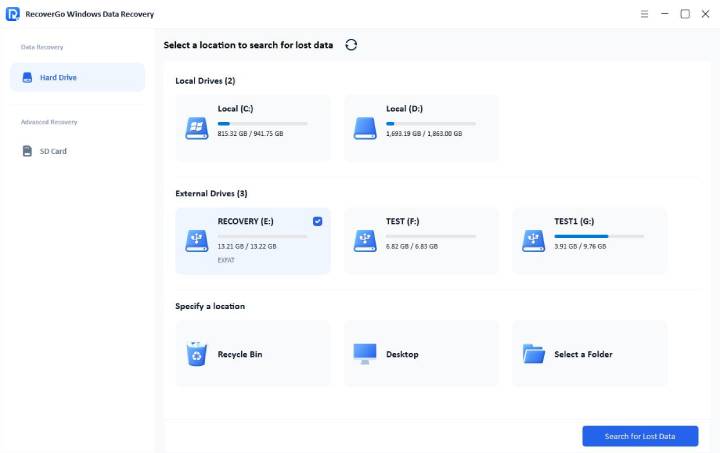
Step 2 iToolab RecoverGo will then start to scan the drive or the folder you have selected. The time it takes to scan will depend on how much data you have on the drive. To ensure that the process is completed quickly, make sure not to use the computer during the scanning.
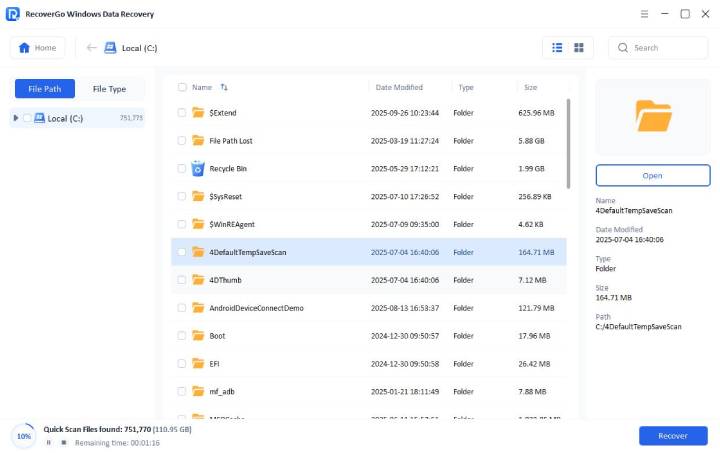
Step 3 After the scan is complete, you will see a complete list of all the files along with other relevant details. You can also search for a specific file or folder that you want to recover from the list.
After finding the data you want to recover, click on “Preview”. After confirming that it is the right file, just click on the Recover button.

Step 4 Now, you must choose a location where you want to store the recovered files. It is best to choose a different drive in order to avoid data overwriting.
After the recovery process is complete, you can view the data by clicking on “Check Recovered data”.
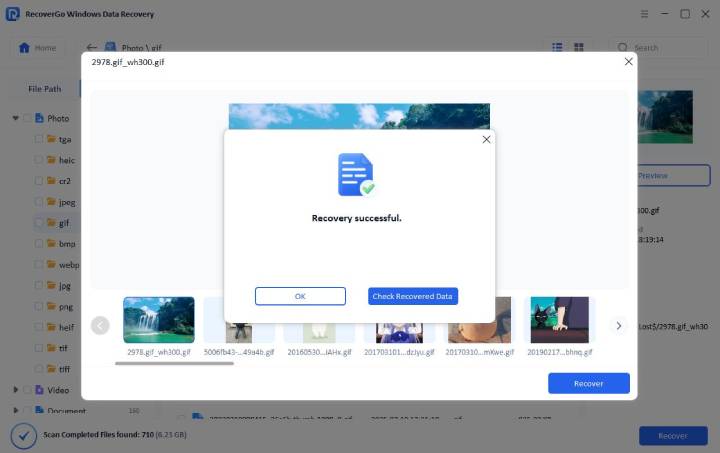
Summary
One of the most common questions Windows users ask is, “Does System Restore restore deleted files?” The short answer is no.
System Restore is only meant to revert the system settings and OS back to a working state. You can’t use this feature to recover the deleted files on a Windows computer.
But if you have deleted files and now want to recover them, then you will need to use a powerful tool like iToolab RecoverGo Windows Data Recovery. This data recovery tool has a very high success rate and allows you to recover any type of file quickly.
The best part about iToolab RecoverGo is that it is very easy to use. With a few simple steps, you can even recover the files that are not present in the Recycle Bin.

